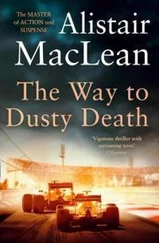‘A private yacht. You mean the–?’ I could feel the hairs on the back of my neck prickling, I’d almost made the blunder that would have finished everything. It had been on the tip of my tongue to say the Temptress – but no one knew I’d ever heard that name, except Mary Ruthven, who’d told me. ‘You mean the general’s private yacht? He has one?’
‘Larry and I certainly haven’t one,’ he grinned. ‘Larry and I’ – an off-beat phrase, but there was nothing in it for me, so I let it pass. ‘Of course it’s the general’s yacht.’
I nodded. ‘And equally of course you have the bathyscaphe somewhere near here. Would you mind telling me what in the world you want a bathyscaphe for?’
‘Certainly not. You’ll have to know anyhow. We are – ah – treasure-hunting, Talbot.’
‘Don’t tell me you believe this Captain Kidd and Blackbeard nonsense,’ I sneered.
‘Recovering your courage, eh, Talbot? No, it’s rather more recent than that and very close to here.’
‘How did you find it?’
‘How did we find it?’ Vyland seemed to have forgotten his urgency; like every criminal who ever lived he had a streak of the ham in him and wouldn’t pass up the chance of basking in the glow of his own glory. ‘We had a vague idea where it was. We tried trawling for it – in the days before I met the general, that was – but had no success. Then we met the general. As you may not know, the general provides his yacht for his geologists when they plod around setting off their little bombs on the bottom of the ocean tuning in with their seismographic instruments to find out where the oil strata are. And while they were doing this we were plotting the ocean bed with an extremely sensitive depth recorder. We found it all right.’
‘Near here?’
‘Very near.’
‘Then why haven’t you recovered it?’ Talbot giving his impression of a salvage specialist so engrossed in a problem that he has forgotten his own circumstances.
‘How would you recover it, Talbot?’
‘Diving for it, of course. Should be easy in those waters. After all, there’s a huge continental shelf here, you have to go a hundred miles out from any point off the west coast of Florida before you even reach five hundred feet. We’re close inshore here. Hundred feet, hundred fifty?’
‘The X 13 is standing in how much, General?’
‘One-thirty feet low tide,’ Ruthven said mechanically.
I shrugged. ‘There you are then.’
‘There we are not.’ Vyland shook his head. ‘What’s the greatest depth at which you can expect divers to perform really useful work, Talbot?’
‘Perhaps three hundred feet.’ I thought a moment. ‘The deepest I know was by US divers off Honolulu. Two hundred and seventy-five feet. US Submarine F4.’
‘You really are a specialist, aren’t you, Talbot?’
‘Every diver and salvage man worth his salt knows that.’
‘Two hundred and seventy-five feet, eh? Unfortunately, what we’re after is in the bottom of a big hole, a deep chasm in the sea bed. The general’s geologists were very interested indeed when we located this hole. Said it was just like – what was it, General?’
‘The Hurd Deep.’
‘That’s it. The Hurd Deep. In the English Channel. Deep valley in the sea-bed where the Limeys dump all their old explosives. This one here is four hundred and eighty feet in depth.’
‘That makes a difference,’ I said slowly.
‘Doesn’t it now? And how would you get at that?’
‘All depends how difficult it is to reach. The newest Neufeldt-Kuhnke rigid diving-suit, armour-plated in cast steel, could just about make it. I doubt if any diver could accomplish anything at that depth. He’d be under a pressure of two hundred pounds to the square inch and any movement would be like a barrel of heavy tar. Anything except the simplest manoeuvre would be beyond him. The way to do it would be with observation turrets – Galeazzi and my old firm, Siebe-Gorman, produce the best – and use those. They can go down about one thousand five hundred feet. You get inside one of these and use a phone to guide laying of explosives or dredgers or grapnels or power grabs. That’s the way they took over ten million dollars’ worth of gold from the Niagara , from about the same depth, off New Zealand, and about four million dollars’ worth of gold from the Egypt , lying four hundred feet off Ushant. Those are the two classic cases of modern times and that’s how I would do it.’
‘And of course that would require at least a couple of surface vessels and much specialized equipment,’ Vyland said softly. ‘Do you think we can go around buying up observation turrets – if there are any available in this country – and dredgers and then sit anchored in the same spot for weeks without exciting suspicion?’
‘You have a point,’ I admitted.
‘So the bathyscaphe,’ Vyland smiled. ‘The valley in the sea floor is less than six hundred yards from here. We take with us grabs and hooks attached to wires on drums fastened to the outside of the scaphe, fix them on – you can do some very fancy work with those extension arms and graphs fitted in front – then come back here, unreeling the wire as we go. Then we haul the wire in from the X 13.’
‘As easy as that, eh?’
‘Just as easy as that, Talbot. Clever, you would say?’
‘Very.’ I didn’t think it clever at all, I didn’t think Vyland had even begun to appreciate the difficulties involved, the endless slow-motion try, try, try again frustration of underwater salvage, the scope of the initial preparation, the skill and experience of years required. I tried to remember how long it had taken to salvage two and a half million dollars’ worth of gold and silver from the Laurentic , sunk in only just over a hundred feet of water – something like six years if I remembered rightly. And Vyland spoke as if he was going to do it in an afternoon. ‘And where exactly is the scaphe?’ I asked.
Vyland pointed at the semi-circular trunking. ‘That’s one of the support legs of this rig – but it happens to be raised twenty feet above the sea bed. The bathyscaphe is moored below that.’
‘Moored below it?’ I stared at him. ‘What do you mean? It’s beneath the bottom of that leg? How did you get it there? How do you get into it? How in the world–?’
‘Simple,’ he interrupted. ‘I am not, as you may have gathered, much of an engineer but I do have an – ah – professional friend who is. He devised the simple expedient of fitting a reinforced and completely waterproof steel floor of great strength across the bottom of this leg – about six feet from the bottom, actually – and letting into this a tapering steel cylinder about six feet long and not quite three feet in diameter, projecting downwards, open top and bottom, but the top capable of being sealed off flush with the waterproof floor by a screwed hatch. In a recession about two feet from the top of this cylinder is a reinforced rubber tube … You begin to see daylight, I think, Talbot?’
‘I see daylight.’ They were an ingenious bunch, if nothing else. ‘Somehow – almost certainly at night – you got the rig’s engineer’s to co-operate with you in the lowering of this leg – I suppose you told them the yarn about top secret research, so secret that no one was allowed to see what was going on. You had the bathyscaphe on the surface, unbolted its bridge cover, lowered the leg slowly until this cylinder fitted over the bathyscaphe’s entrance hatch, pumped this rubber ring full of compressed air to make a perfect seal, then lowered the leg into the water, pushing the bathyscaphe down before it while someone inside the bathyscaphe, probably your engineering friend, adjusted the hydrostatic valve for one of the adjacent flooding chambers enough to let it sink easily but not so much as to rob it of its slight positive buoyancy necessary to keep the top of the entrance chamber jammed into the cylinder at the foot of the leg. And when you want to take off you just climb into the bathyscaphe, seal both the cylinder and the bathyscaphe hatches, have someone on the rig blow the air from the rubber seal gripping the entrance chamber of the bathyscaphe, flood your tanks to get enough negative buoyancy to drop clear of the leg and there you are. Reverse process when you come back except that you’ll need a suction pump to clear the water that’s accumulated in the cylinder. Right?’
Читать дальше
Конец ознакомительного отрывка
Купить книгу












